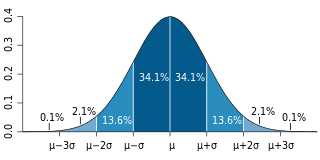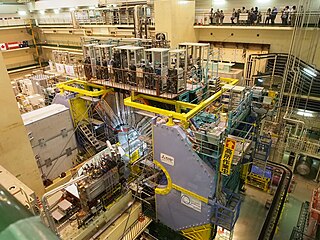
Frequency, most often measured in hertz, is the number of occurrences of a repeating event per unit of time. It is also occasionally referred to as temporal frequency for clarity and to distinguish it from spatial frequency. Ordinary frequency is related to angular frequency by a factor of 2π. The period is the interval of time between events, so the period is the reciprocal of the frequency: T = 1/f.

In economics, the Gini coefficient, also known as the Gini index or Gini ratio, is a measure of statistical dispersion intended to represent the income inequality, the wealth inequality, or the consumption inequality within a nation or a social group. It was developed by Italian statistician and sociologist Corrado Gini.

In probability theory and related fields, a stochastic or random process is a mathematical object usually defined as a family of random variables in a probability space, where the index of the family often has the interpretation of time. Stochastic processes are widely used as mathematical models of systems and phenomena that appear to vary in a random manner. Examples include the growth of a bacterial population, an electrical current fluctuating due to thermal noise, or the movement of a gas molecule. Stochastic processes have applications in many disciplines such as biology, chemistry, ecology, neuroscience, physics, image processing, signal processing, control theory, information theory, computer science, and telecommunications. Furthermore, seemingly random changes in financial markets have motivated the extensive use of stochastic processes in finance.

Cluster analysis or clustering is the task of grouping a set of objects in such a way that objects in the same group are more similar to each other than to those in other groups (clusters). It is a main task of exploratory data analysis, and a common technique for statistical data analysis, used in many fields, including pattern recognition, image analysis, information retrieval, bioinformatics, data compression, computer graphics and machine learning.
Scientometrics is a subfield of informetrics that studies quantitative aspects of scholarly literature. Major research issues include the measurement of the impact of research papers and academic journals, the understanding of scientific citations, and the use of such measurements in policy and management contexts. In practice there is a significant overlap between scientometrics and other scientific fields such as information systems, information science, science of science policy, sociology of science, and metascience. Critics have argued that overreliance on scientometrics has created a system of perverse incentives, producing a publish or perish environment that leads to low-quality research.
Citation impact or citation rate is a measure of how many times an academic journal article or book or author is cited by other articles, books or authors. Citation counts are interpreted as measures of the impact or influence of academic work and have given rise to the field of bibliometrics or scientometrics, specializing in the study of patterns of academic impact through citation analysis. The importance of journals can be measured by the average citation rate, the ratio of number of citations to number articles published within a given time period and in a given index, such as the journal impact factor or the citescore. It is used by academic institutions in decisions about academic tenure, promotion and hiring, and hence also used by authors in deciding which journal to publish in. Citation-like measures are also used in other fields that do ranking, such as Google's PageRank algorithm, software metrics, college and university rankings, and business performance indicators.
The h-index is an author-level metric that measures both the productivity and citation impact of the publications, initially used for an individual scientist or scholar. The h-index correlates with success indicators such as winning the Nobel Prize, being accepted for research fellowships and holding positions at top universities. The index is based on the set of the scientist's most cited papers and the number of citations that they have received in other publications. The index has more recently been applied to the productivity and impact of a scholarly journal as well as a group of scientists, such as a department or university or country. The index was suggested in 2005 by Jorge E. Hirsch, a physicist at UC San Diego, as a tool for determining theoretical physicists' relative quality and is sometimes called the Hirsch index or Hirsch number.

John P. A. Ioannidis is a Greek-American physician-scientist, writer and Stanford University professor who has made contributions to evidence-based medicine, epidemiology, and clinical research. Ioannidis studies scientific research itself - in other words, meta-research - primarily in clinical medicine and the social sciences.

"Why Most Published Research Findings Are False" is a 2005 essay written by John Ioannidis, a professor at the Stanford School of Medicine, and published in PLOS Medicine. It is considered foundational to the field of metascience.
Since the launch of Twitter on July 15, 2006, there have been many notable uses for the service in a variety of environments, including political, economic, social and cultural uses. As users tweet their messages on Twitter, they encourage other people to respond and engage in online discussions as well as offline activities. User engagement on Twitter is usually measured with likes, replies and retweets and is a form of social power. After the 2022 acquisition of Twitter by Elon Musk, the platform rebranded to the name X; however, it is still widely referred to as Twitter.

In scholarly and scientific publishing, altmetrics are non-traditional bibliometrics proposed as an alternative or complement to more traditional citation impact metrics, such as impact factor and h-index. The term altmetrics was proposed in 2010, as a generalization of article level metrics, and has its roots in the #altmetrics hashtag. Although altmetrics are often thought of as metrics about articles, they can be applied to people, journals, books, data sets, presentations, videos, source code repositories, web pages, etc.
The Kakwani index is a measure of the progressivity of a social intervention, and is used by social scientists, statisticians, and economists. It is named after the economist who first proposed and used it, Nanak Chand Kakwani.

The replication crisis is an ongoing methodological crisis in which the results of many scientific studies are difficult or impossible to reproduce. Because the reproducibility of empirical results is an essential part of the scientific method, such failures undermine the credibility of theories building on them and potentially call into question substantial parts of scientific knowledge.

The Belle II experiment is a particle physics experiment designed to study the properties of B mesons and other particles. Belle II is the successor to the Belle experiment, and commissioned at the SuperKEKB accelerator complex at KEK in Tsukuba, Ibaraki prefecture, Japan. The Belle II detector was "rolled in" in April 2017. Belle II started taking data in early 2018. Over its running period, Belle II is expected to collect around 50 times more data than its predecessor, mostly due to a 40-fold increase in an instantaneous luminosity provided by SuperKEKB as compared to the previous KEKB accelerator.
Metascience is the use of scientific methodology to study science itself. Metascience seeks to increase the quality of scientific research while reducing inefficiency. It is also known as "research on research" and "the science of science", as it uses research methods to study how research is done and find where improvements can be made. Metascience concerns itself with all fields of research and has been described as "a bird's eye view of science". In the words of John Ioannidis, "Science is the best thing that has happened to human beings ... but we can do it better."
Quantum volume is a metric that measures the capabilities and error rates of a quantum computer. It expresses the maximum size of square quantum circuits that can be implemented successfully by the computer. The form of the circuits is independent from the quantum computer architecture, but compiler can transform and optimize it to take advantage of the computer's features. Thus, quantum volumes for different architectures can be compared.
Attention inequality is the inequality of distribution of attention across users on social networks, people in general, and for scientific papers. Yun Family Foundation introduced "Attention Inequality Coefficient" as a measure of inequality in attention and arguments it by the close interconnection with wealth inequality.

Channa Jayasumana is a Sri Lankan medical academic, politician, Cabinet Minister, and member of the Parliament of Sri Lanka for the Anuradhapura District.
The science-wide author databases of standardized citation indicators is a multidimensional ranking of the world's scientists produced since 2015 by a team of researchers led by John P. A. Ioannidis at Stanford.
The composite index or composite indicator is a new numerical indicator that evaluates the quality of a scientist's research publications, regardless of the scientific field in which he/she operates.
















